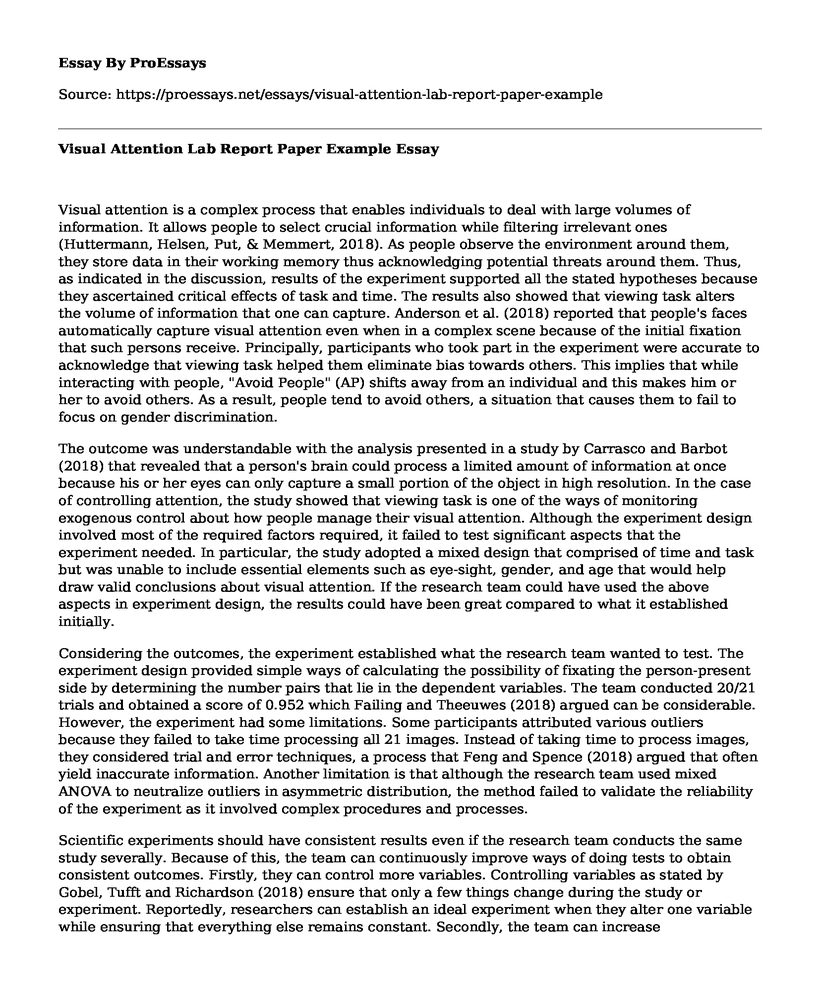Visual attention is a complex process that enables individuals to deal with large volumes of information. It allows people to select crucial information while filtering irrelevant ones (Huttermann, Helsen, Put, & Memmert, 2018). As people observe the environment around them, they store data in their working memory thus acknowledging potential threats around them. Thus, as indicated in the discussion, results of the experiment supported all the stated hypotheses because they ascertained critical effects of task and time. The results also showed that viewing task alters the volume of information that one can capture. Anderson et al. (2018) reported that people's faces automatically capture visual attention even when in a complex scene because of the initial fixation that such persons receive. Principally, participants who took part in the experiment were accurate to acknowledge that viewing task helped them eliminate bias towards others. This implies that while interacting with people, "Avoid People" (AP) shifts away from an individual and this makes him or her to avoid others. As a result, people tend to avoid others, a situation that causes them to fail to focus on gender discrimination.
The outcome was understandable with the analysis presented in a study by Carrasco and Barbot (2018) that revealed that a person's brain could process a limited amount of information at once because his or her eyes can only capture a small portion of the object in high resolution. In the case of controlling attention, the study showed that viewing task is one of the ways of monitoring exogenous control about how people manage their visual attention. Although the experiment design involved most of the required factors required, it failed to test significant aspects that the experiment needed. In particular, the study adopted a mixed design that comprised of time and task but was unable to include essential elements such as eye-sight, gender, and age that would help draw valid conclusions about visual attention. If the research team could have used the above aspects in experiment design, the results could have been great compared to what it established initially.
Considering the outcomes, the experiment established what the research team wanted to test. The experiment design provided simple ways of calculating the possibility of fixating the person-present side by determining the number pairs that lie in the dependent variables. The team conducted 20/21 trials and obtained a score of 0.952 which Failing and Theeuwes (2018) argued can be considerable. However, the experiment had some limitations. Some participants attributed various outliers because they failed to take time processing all 21 images. Instead of taking time to process images, they considered trial and error techniques, a process that Feng and Spence (2018) argued that often yield inaccurate information. Another limitation is that although the research team used mixed ANOVA to neutralize outliers in asymmetric distribution, the method failed to validate the reliability of the experiment as it involved complex procedures and processes.
Scientific experiments should have consistent results even if the research team conducts the same study severally. Because of this, the team can continuously improve ways of doing tests to obtain consistent outcomes. Firstly, they can control more variables. Controlling variables as stated by Gobel, Tufft and Richardson (2018) ensure that only a few things change during the study or experiment. Reportedly, researchers can establish an ideal experiment when they alter one variable while ensuring that everything else remains constant. Secondly, the team can increase randomization to minimize sample bias. Rather than including only time and task in the experiment, the team can consider gender, age, location, and eye-sight to reduce a specific validity issue.
Conclusion
As mentioned earlier, during the experiment, the research team experienced some limitations. Therefore, it is essential to address these issues to enhance further investigation. Before conducting another analysis, researchers should train and educate participants on the importance of taking adequate time to process images required to complete the study (Lu, Yang, Batra, & Parikh, 2016). In doing so, the team will establish accurate results regarding visual attention. It is also significant to conduct further research because the experiment has failed to indicate some of the factors that affect or reduce the visual recognition of individuals.
References
Anderson, P., He, X., Buehler, C., Teney, D., Johnson, M., Gould, S., & Zhang, L. (2018). Bottom-up and top-down attention for image captioning and visual question answering. In CVPR (Vol. 3, No. 5, p. 6).
Carrasco, M., & Barbot, A. (2018). Attention alters appearance. Current Opinion in Psychology.
Failing, M., & Theeuwes, J. (2018). Selection history: How reward modulates selectivity of visual attention. Psychonomic Bulletin & Review, 25(2), 514-538.
Feng, J., & Spence, I. (2018). Playing action video games boosts visual attention. In Video Game Influences on Aggression, Cognition, and Attention (pp. 93-104). Springer, Cham.
Gobel, M. S., Tufft, M. R., & Richardson, D. C. (2018). Social beliefs and visual attention: How the social relevance of a cue influences spatial orienting. Cognitive Science, 42, 161-185.
Huttermann, S., Helsen, W. F., Put, K., & Memmert, D. (2018). Does visual attention impact on decision making in complex dynamic events? Journal of Sport and Exercise Psychology, 40(3), 163-166.
Lu, J., Yang, J., Batra, D., & Parikh, D. (2016). Hierarchical question-image co-attention for visual question answering. In Advances In Neural Information Processing Systems (pp. 289-297).
Cite this page
Visual Attention Lab Report Paper Example. (2022, Nov 20). Retrieved from https://proessays.net/essays/visual-attention-lab-report-paper-example
If you are the original author of this essay and no longer wish to have it published on the ProEssays website, please click below to request its removal:
- Research Design Questions and Hypothesis
- Least Developed Countries
- How Fire Alarm Circuit Works
- Research Paper on Applied Trigonometry and Geometry
- Strategic Management and Leadership of AirAsia Paper Example
- Keplers Law - Essay Sample
- Unlocking the Potential of Research Sources for Graduate Learners - Essay Sample







